Water bugs create serious issues in pools. They can infest pools in their hundreds and some of them can even bite people relaxing in the warm pool water.
While not all water bugs bite, all of them are known for creating a less inviting pool. They are difficult to eliminate since they are mostly attracted to food that needs to be eliminated first.
Water bugs come in all shapes and sizes. There are thousands of species and sub-species of water bugs found in pools.
As they can often fly, water bugs easily move from one source of water to another seeking food and a place to reproduce.
You first need to identify the type of water bug in your pool to get rid of it. Some water bugs only eat other water bugs while others only eat algae.
However, water bugs in pools often depend on each other. Most importantly, water bugs in pools attract other species of water bugs.
Table of Contents
Water Bug Identification
Water bugs are known to come in different sizes and colors. They are sometimes misidentified as either mosquitoes or roaches, depending on their species.
Water bugs have a size between a few millimeters and a few inches. Sizing is mostly influenced by water bug species.
Water Boatmen and Backswimmers are known to be a few times smaller than Giant Water Bugs. Assessing their size and color lets you correctly identify a species.
Most water bugs are either grey, brown, or black. They lack vivid coloring as they often rely on camouflage, especially in the case of predatory water bugs.
4 Types of Water Bugs in The Pool
Many water bugs make their way into pools. The dirtier the pool the higher the chances of seeing water bugs in it are.
1. Water Boatmen
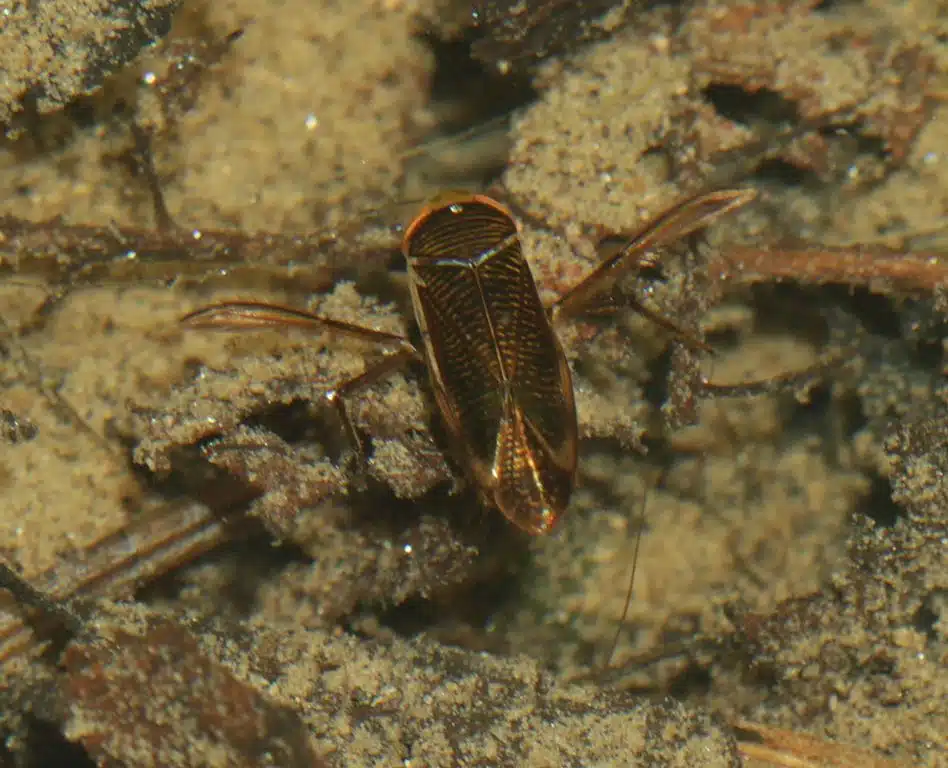
Water Boatmen are types of common water bugs named by their physical shape which resembles a boat.
These elongated water bugs are actually of different species. There are hundreds of species of Water Boatmen but they are similar in size and habitats.
Known for its boat shape or elongated oval shape tapering at the ends, this water bug grows to around 0.5 inches.
These water bugs are very good swimmers. Water Boatmen are lighter than water which means they can dive below the surface, especially looking for algae.
These water bugs are common in pools. They don’t bite people and they’re generally interested in algae. A pool without algae doesn’t offer any food for these water bugs.
Water Boatmen are known for grabbing algae at the bottom of the pool using their long forelegs.
Apart from using algae and microorganisms growing on algae as food this species is also known for using algae for mating.
Water Boatmen lay eggs directly on algae which means a pool without algae isn’t a proper habitat for these eggs.
Part of the Corixidae group of water bugs, Water Boatmen are known for being able to stay a long time underwater.
They do this by trapping air bubbles with their bodies.
Many assume air bubbles are released so that they don’t float back up. But Water Boatmen grab underwater vegetation to stay at the bottom of the pool.
These water bugs are common in lakes and streams. They live here as there’s plenty of vegetation to feed on.
They are also common in pools.
2. Backswimmers
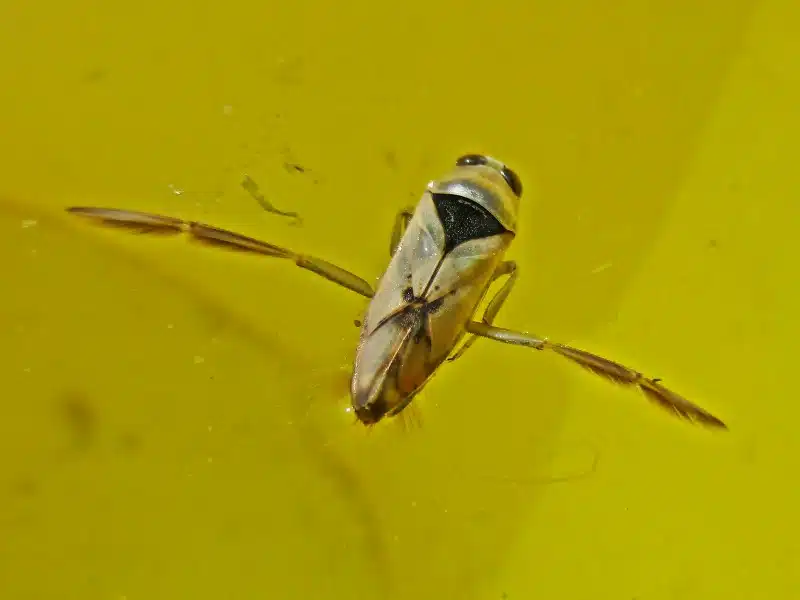
Backswimmers are part of the Hemiptera genus. These bugs swim with their backs down which insiders their name and makes them easy to recognize as you can see their abdomen and legs in the pool first.
Backswimmers are always visible at the surface of the water. They only dive when it comes to food.
A trapped air bubble allows them to breathe underwater. However, they need to grab on to vegetation not to resurface.
Backswimmers can fly and move from one pool to another isn’t complicated, especially at night when they’re attracted by artificial lights.
Backswimmers can bite, and this is why many people fear them.
As true bugs, they feed on small fish or tadpoles. Sharp mouthparts allow them to pierce prey and consume them.
Backswimmers hold on to vegetation until prey catches their attention nearby.
3. Water Skimmers
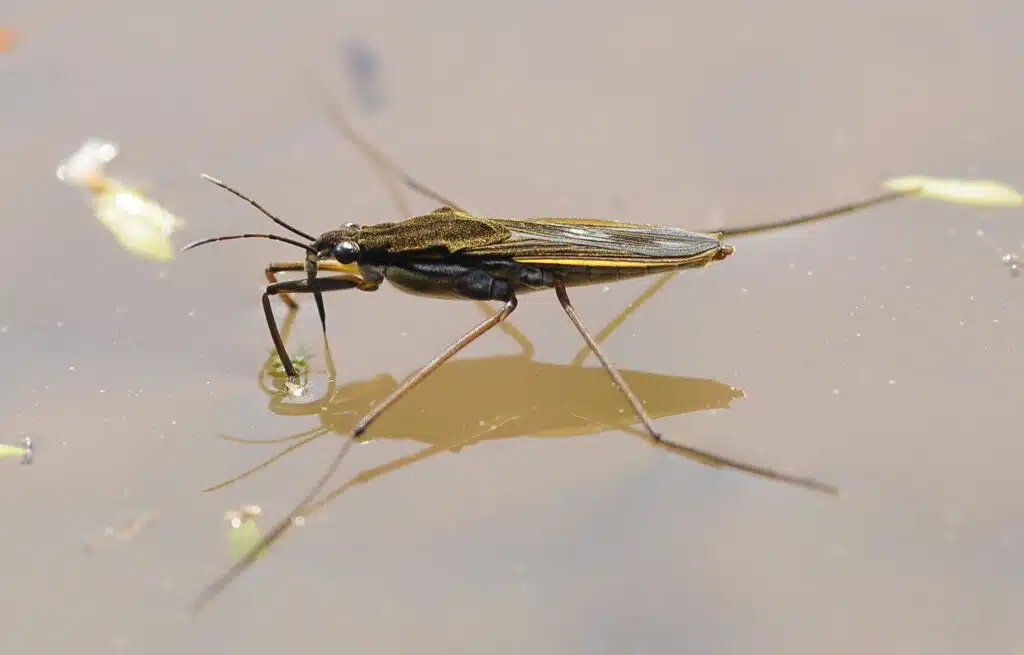
These water bugs grow up to 0.9 inches. They have a flattened elongated body with long legs.
There are over 300 species of Water Skimmers around the world.
Known for having hundreds of micro-hairs on their bodies, Water Skimmers can float.
These water bugs are often seen in clusters on the surface of the water. While they live together, they can also eat each other whenever their populations spiral.
Water skimmers can be wingless, winged, or winged with short wings.
Over 300 species of Water skimmers live in freshwaters such as lakes and streams. A single species of Water skimmer lives in saltwater.
Resembling mosquitoes, Water Skimmers are both predators and scavengers.
They are known to eat small insects.
Water skimmers don’t bite.
4. Giant Water Bugs
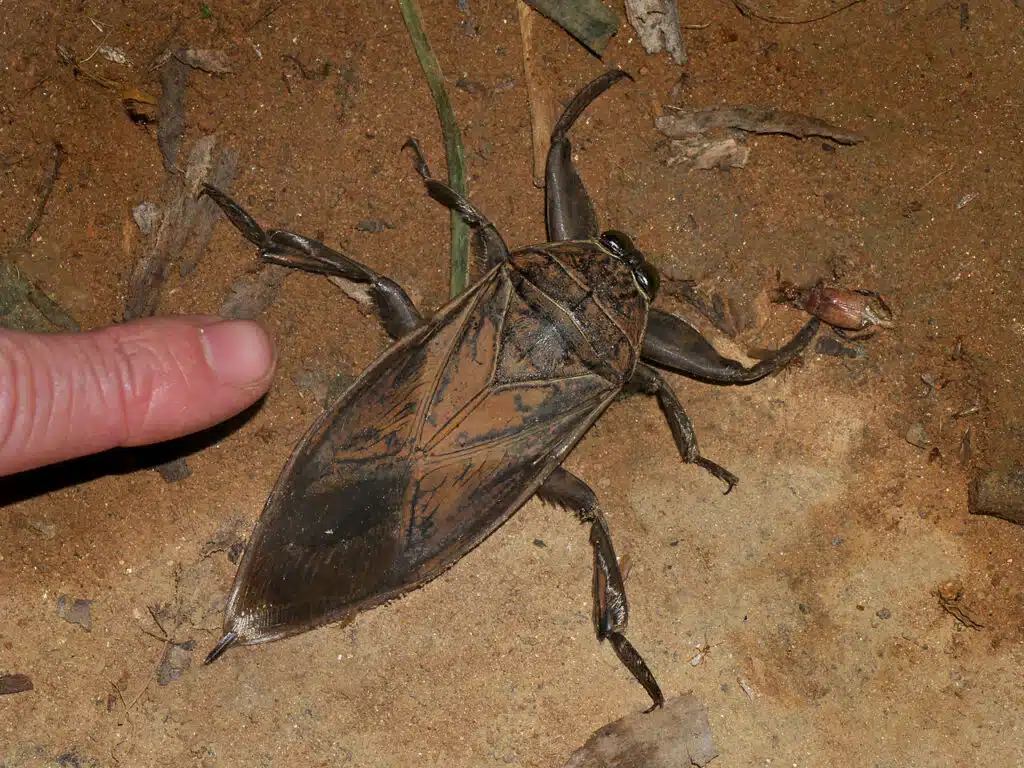
Giant Water Bugs resemble cockroaches as they grow up to a few inches. They have a flat body of a gray color and they are known to swim and dive.
These bugs eat small fish and tadpoles. They can also be found in home pools asides from their natural habitat in ponds and marshes.
Giant Water Bugs are known to bite people. Their bite is accompanied by pain.
These water bugs are some of the most complex as they are known to even fake their death. They appear motionless for minutes when taken out of the water.
Like many other animals such as snakes, Giant Water Bugs are also known to release a foul smell to keep predators away.
How Do Water Bugs Get into The Pool?
Water bugs get in pools by crawling or flying. Many species are nocturnal and easily guide themselves to pools by following lights around homes and backyards.
Artificial lights
Water bugs are attracted to lights. They can fly from one pool to another simply by following outdoor lights or lights in homes at night.
Artificial lights also attract a wider range of insects, which in turn can also attract predatory water bugs.
Not all water bugs are foragers. Some exclusively feed on other water bugs, insects, or certain fly eggs.
As a result, artificial lights around the pool start a chain reaction where they attract water bugs which also attract other species of water bugs in return.
Algae and plant matter
Algae in pool water also attract water bugs. It serves their feeding purposes. Some water bugs use their forelegs to gather algae and consume it together with other microorganisms.
Algae in the pool might not be visible at first. However, the greener the water in the pool the higher the chances of algae are for water bugs to try to consume.
Mosquito larvae
Mosquitoes are known to attract beneficial water bugs. Water Boatman bugs are known to eat mosquito eggs. They clear mosquitoes out of the pool.
However, Water Boatman bugs also stay in the pool once mosquitoes have been eliminated attracting predatory water bugs such as Backswimmer water bugs in turn.
Mosquitoes and other insects attract a wide range of water bugs as they’re seen as a quick meal most times.
To eat other water bugs
Water bugs can also enter pools seeking non-predatory water bugs. Backswimmers are only known to be attracted to pools they find water bugs such as Water Boatman.
These types of predatory water bugs don’t stay in a pool where they can starve. They constantly seek other flies and bugs to eat.
Water Boatman bugs fly in pools. They use their wings to move around the pool and to establish their ground whenever looking for food. They can dive and are generally known for being agile and resilient as they can go a long time without food.
Backswimmer bugs fly in pools and are seen with their legs and abdomen up, almost appearing dead. These water bugs fly into pools with Water Boatman bugs.
Why Do You Need To Remove Water Bugs in The Pool?
While you might not be sure what to do about water bugs in your pool you need to know these bugs come with certain risks.
They carry diseases and they can even bite, which isn’t the type of experience you want in your pool.
Water bugs attract other water bugs inside the pool
One of the biggest problems with allowing just a few water bugs inside your pool is the fact they attract others.
Predatory water bugs are attracted to forager bugs in pools. Living them in the water is not recommended, especially since water bugs can lay eggs each week becoming more numerous from one day to another.
Water bugs may bite
Some water bugs can bite and this is a good reason to remove them from pools. Water bug bites are rare but painful.
It’s worth following the steps recommended to remove these water bugs to avoid being bitten while swimming in the pool.
They make your pool look uninviting
Another reason to remove bugs and bug eggs in the pool is to make it more inviting. Nobody wants to swim in a dirty pool where insects and bugs are floating around.
Maintaining clean water and clean pool premises is a must when it comes to relaxing after a long day.
Water bugs might make you sick
Water bugs can bite and invade pools but they also carry diseases. These bugs are known to cause certain skin conditions plus gastrointestinal problems.
- Dysentery
Dysentery is a severe form of diarrhea. This type of disease is prompted by water bugs and requires medical attention.
Dysentery is diarrhea that contains mucus or even blood. Bacteria in water and caused by water bugs can lead to this extreme type of diarrhea which comes with extreme dehydration and the need to seek a doctor.
- Gastrointestinitis
Bacterias and other types of viral spread are known to be the cause of gastrointestinitis. This is a type of diarrhea that’s accompanied by vomiting and extreme vomiting.
Gastrointestinitis is known to be prevalent in children. This is why families that have pools and children should be specifically interested to monitor water quality for possible water bug infestations.
- Skin diseases
Skin diseases caused by water bugs are rare in the US compared to cases in other parts of the world. However, research shows Buruli ulcer is caused by water bugs in certain parts of Africa and Australia.
Some species of water bugs are known to carry the Mycobacterium ulcerans bacteria. This bacteria is responsible for Buruli ulcers.
This type of ulcer is known to cause skin infections and ulcers that destroy the skin.
Other types of skin conditions can also be triggered by water bugs. Skin rashes or red skin can often be a reaction to bugs in the water.
People with allergies or those more vulnerable to allergies are among the first to see these skin reactions whenever swimming in a pool with water bugs in it.
Some of these allergies might be caused by a specific type of water bug. But a clean pool needs to be free of all types of water bugs, regardless of which of them causes a skin condition such as Buruli ulcer, rashes, or red skin.
How to Get Rid of Water Bugs in The Pool?
Getting rid of water bugs in the pool is a multi-step process. Most of the steps below are recommended together as simply removing the bugs from the water isn’t enough to make pool water safe.
Skim and brush the pool
Pool skimmers are some of the best tools to control water bugs in in-ground pools. Skimmers are normally built into the side walls of the pool where they draw surface-level water from.
Pool skimmers filtrate the water on the surface for hairs, skin, bugs, and other floating debris. They are used to filtrate many types of water bugs.
Pool skimmers need to be used frequently to keep pool water clean.
They are normally used with pool brushes. These types of brushes are known to quickly eliminate algae build-up or formation in certain areas of the pool where water isn’t flowing or filtering properly.
You need to use a pool brush frequently to ensure algae isn’t forming and that water bugs aren’t attracted to your pool.
Use a pool vacuum cleaner
Pool vacuum cleaners are connected to the pool skimmer. They move around the pool vacuuming all types of debris and bugs sending the suctioned particles to the skimmer.
Sediment is mostly removed by vacuum cleaners. This sediment then makes its way to the skimmer and to the pool filter essentially ensuring it doesn’t return to the pool.
A powerful pool vacuum cleaner is one of the top tools used to limit or eliminate water bugs from a pool.
Pool shock
Pool shocking is the process in which you add chlorine chemicals to the water. Non-chlorine-based chemicals can also be added with pool shocking.
This is the process that adds chlorine to the level where algae aren’t formed anymore. Bacteria in water are also killed with pool shock.
24-hours pump action
Keeping the pool pump running for at least 24 hours ensures filtration can happen. This is the permanent process from which water bugs cannot escape.
Pool care professionals recommend running the pump for at least 24 hours to eliminate water bugs.
Test water quality
Checking pool water quality frequently is recommended for keeping water bugs away, especially when it comes to possible low-quality water and algae formation.
- pH water levels
Pool water needs to be within 7 and 7.6pH levels. This is tested with a pH testing kit. Pool water test kits test both chlorine and pH levels.
- Chlorine levels
Chlorine levels of up to 3 parts per million (ppm) are recommended for healthy pool water. These chlorine levels are tested as frequently as water pH levels.
Eliminate (good) Water Boatmen to deter Backswimmers
Water bugs in the pool are known to attract other water bugs. Some people deliberately live Water Boatmen in the pool so they can eat mosquitoes.
But living any type of bugs or flies in the pool isn’t recommended as they tend to attract other predatory water bugs and species.
How To Prevent Water Bugs Get Into The Pool?
Now that the pool is free of water bugs you need to know which measures to take so they don’t return. This is why you need to measure water cleanliness, chlorine levels, and pH levels constantly.
Eliminate algae in the pool
It’s essential to keep algae formation away from the pool for good water quality.
You can consider using algaecide in the pool to keep algae away.
Algaecide can be based on natural or chemical ingredients. Make sure to read the full instructions of the product before using it.
Use chlorine shocks at least once per week
Chlorine shocks work. They need to be regularly used in the pool at least once per week to keep good chlorine levels.
Chlorine shocks and algaecide are generally recommended for water quality first. Water bugs are deterred by pool water with constant chlorine levels.
Skim the pool daily
Skimming the pool consumes energy. However, it also removes all bugs at the surface of the water. Some pool care professionals recommend daily skimming.
Skim timers or manually setting the pool skimmer every day is recommended against water bugs as some may not even be visible at first.
Test water chlorine levels
Chlorine levels between 1 part and 3 parts per million are recommended for good pool water quality.
You should check pool water chlorine levels up to 3 times per week to ensure they kill bacteria that attract water bugs.
Use algaecide
Algaecide is normally added to pools when the pool pump is running. Some people add algaecide after shock treatments.
Algaecide works best with chlorine. Both algaecide and chlorine destroy algae cells stopping their growth and killing them.
FAQ
Most water bugs found in pools can fly. Back Swimmers and Boatmen are known to fly. These are some of the most common types of water bugs found in US pools.
Water bugs can crawl and climb walls. They can also fly which means water bugs can get into the pool as well as into the house by accident.
Water bugs cannot drown. Attached air bubbles allow these bugs to remain underwater for a long period. They only die when starved or squished.
Some water bugs can bite, albeit they rarely bite people. Others don’t bite and are even considered beneficial as they eat mosquitoes and mosquito eggs.
Water bugs carry multiple diseases. They can cause diarrhea, extreme dehydration, and gastrointestinal issues whenever they infest pools. Water bugs can also cause skin irritation or trigger allergies.
Some water buts bite while others don’t. Biting is common whenever water bugs multiply rapidly in a pool, especially in bodies of water with growing algae formations.
Some water bugs don’t make any noise while other larger bugs such as the Giant Water Bug make noise when moving around. Their large bodies which measure up to a few inches are known for making a sound when moving.
Yes, water bugs poop. Water bug droppings are known to cause all types of health problems. When ingested, they can cause diarrhea and dehydration.
Water bugs like artificial light. This is why they often make their way to a certain pool at night whenever there are lights on nearby.
Bleach kills water bugs and other bacteria found in pools. However, it doesn’t kill all bugs which makes it inefficient compared to skimming and other methods of manually removing bugs from pools.
Vinegar kills a small number of water bugs. It’s inefficient as it dilutes in water. Furthermore, it doesn’t eliminate foods water bugs are attracted to which means vinegar doesn’t stop water bugs from returning.
Raid used active chemical ingredients which may kill bugs. It’s an inefficient solution in pools where it only kills a few water bugs. The spray gets diluted in the water.
Boric acid kills water bugs. However, it isn’t safe for people, children, and pets. Other most practical solutions are recommended as an alternative.
Lysol is known to kill water bugs. It prevents them from breathing properly which eventually kills them. The solution doesn’t kill all bugs in the pool.
Borax or boric acid can kill water bugs. It cannot be sprinkled in the pool. Borax is normally sprinkled in areas next to the pool where these bugs move through to kill them so it only has partial efficiency.
Diatomaceous earth is known to erode the exoskeleton of water bugs. It does it inefficiently and only to a small number of water bugs.
Baking soda can theoretically kill bugs. However, baking soda is inefficient in pools where it needs to draw out a lot of water to kill these bugs.
Chlorine is used to keep water bugs away but only when water is clean without algae. Otherwise, chlorine treatments become inefficient.
Water bugs lay eggs in pools. They normally lay eggs in vegetation inside water or algae-rich water. Female water bugs may lay eggs multiple times per year.
Giant Water bug eggs are carried by the male on the back until they hatch. These eggs have an oval shape and an ivory-white color. Backswimmer water bugs lay white eggs on the stems of underwater plants.
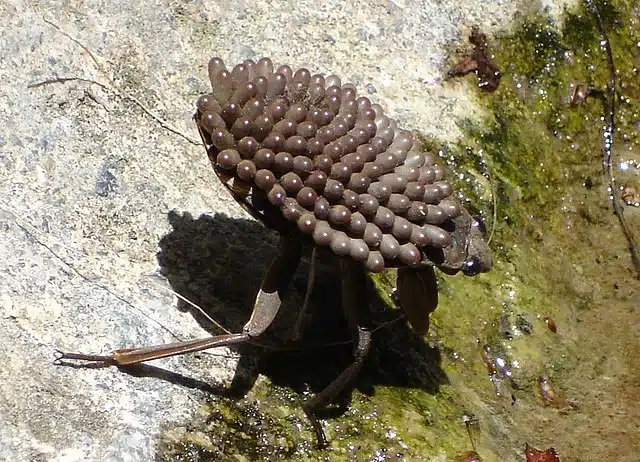
Summary
¼ inch gray Water Boatman bugs and 0.6 light-colored Backswimmers are the most common types of water bugs inside the pool.
One attracts the other and eliminating them involves eliminating both species.
The most common type of bug in the pool is the Water Boatman. This water bug feeds on water algae. It starts feeding on algae as soon as it starts to develop in the pool, well before you can notice it.
This type of water bug is a scavenger, it only eats algae but it attracts predatory water bugs such as Backswimmers.
Backswimmer water bugs are attracted to Water Boatman which it eats. This type of bug doesn’t settle in a pool without bugs to eat.
Both species are common and need to be eliminated together. Chlorine levels, pH levels, and algae levels determine if these bugs can be attracted to the pool. They need to be measured daily or at least 3 times per week.